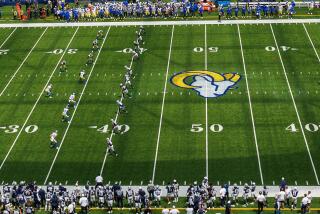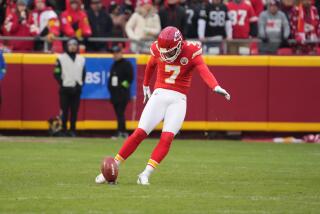The Difference Is Not So Huge
- Share via
Welcome to the NBA zone, a confusing place where defensive players can now be whistled for spending three seconds in the key.
The league made headlines in the off-season by giving teams the go-ahead to play zone defenses, with players free to guard territory rather than specific players. In reality, the league has only altered its illegal defense call--and then only slightly.
Teams simply cannot line up in the sort of 2-3 zone you can see in college games on Saturday afternoons, with two guards stationed out front, two forwards playing several paces behind them and a center patrolling the key.
Under the NBA’s new rules, the center--or any other defensive player, for that matter--cannot station himself in the key without being within arm’s length of an opponent. In other words, the NBA’s zone has a glaring loophole.
“I don’t think it’s going to be much of a factor,” said Clipper Coach Alvin Gentry, echoing early reviews of the new zone rules. “We played 48 minutes the other night against Phoenix, and there were probably 30 seconds of zone between the teams.
“The only zone you can really play leaves the middle totally exposed. You can flash players into the key who can catch the ball and be wide open for shots.
“I’d be surprised if you see teams play a lot of zone defense. The players in this league are just too athletic.”
Indeed, good outside-shooting teams can pick apart a zone with quick passes from one side of the court to the other. Or by feeding the ball inside to a center, who whips a quick pass back to the perimeter, catching the defense out of position.
Plus, as Gentry said of the Clippers’ game plan against the zone: “We’re going to run down there and shoot it before they get it set up.”
Gentry did acknowledge that an effective zone defense might enable an overmatched team to play better defense against league superstars such as Laker center Shaquille O’Neal.
“I guess it gives you an opportunity to guard Shaq a little differently,” he said. “It might give you a 10% better chance to guard the Shaqs, Kobe Bryants and Allen Iversons of the world.”
Recently, the San Antonio Spurs used a zone for the first half of an exhibition against the Houston Rockets. After the Spurs were out-rebounded by the smaller Rockets, 25-10, Coach Gregg Popovich junked the zone to appease his frustrated players.
“I basically had a revolt on my hands,” Popovich said
Zone defenses had been outlawed in the NBA since 1961, although many coaches through the years bent the rules by having defenders away from the ball slack off their men in what most fans would recognize as nothing more than a matchup zone.
The league decided too many teams were running identical offenses as a way to combat the de-facto zones they faced. All too often, games ground to a halt as teams resorted to one-on-one and two-on-two plays, which left more than half the players on the floor watching the action along with the spectators in the stands.
So far, player reaction has been mixed.
O’Neal was initially upset with the changes, although he has softened his stance during the exhibition season. Kevin Garnett of the Minnesota Timberwolves reportedly hates zones.
“They want to change the game that’s been here for ... years,” said Davis Wesley, a Charlotte Hornet guard. “I don’t know. I still think a lot of stuff they wanted to eliminate is going to go on. Just because you can play a zone doesn’t mean you’re going to want to play it all the time.”
At least one coach is giving zone defenses the benefit of a doubt, however.
“With the team that we have, we stood to benefit more than any other team in the league. I’ve said that from Day 1,” Minnesota Coach Flip Saunders said. “At least in the preseason, it hasn’t been proven wrong at this point. We’re long, we’re athletic.”
Laker Coach Phil Jackson is concerned that frequent whistles will bog down games with numerous calls for defensive three seconds, which results in a technical foul against the offending team.
“I think they’re going to have more violations than they’ve ever had before,” Jackson said. “And it’s going to leave the fans going like, ‘What? What was that about? A stop of play again?’
“We had five of them in one quarter the other night, and that’s what we really want to get away from--the stop in play, the confusion that fans have, that they don’t understand the game because of it.”
*
The Associated Press contributed to this report.
More to Read
Go beyond the scoreboard
Get the latest on L.A.'s teams in the daily Sports Report newsletter.
You may occasionally receive promotional content from the Los Angeles Times.






